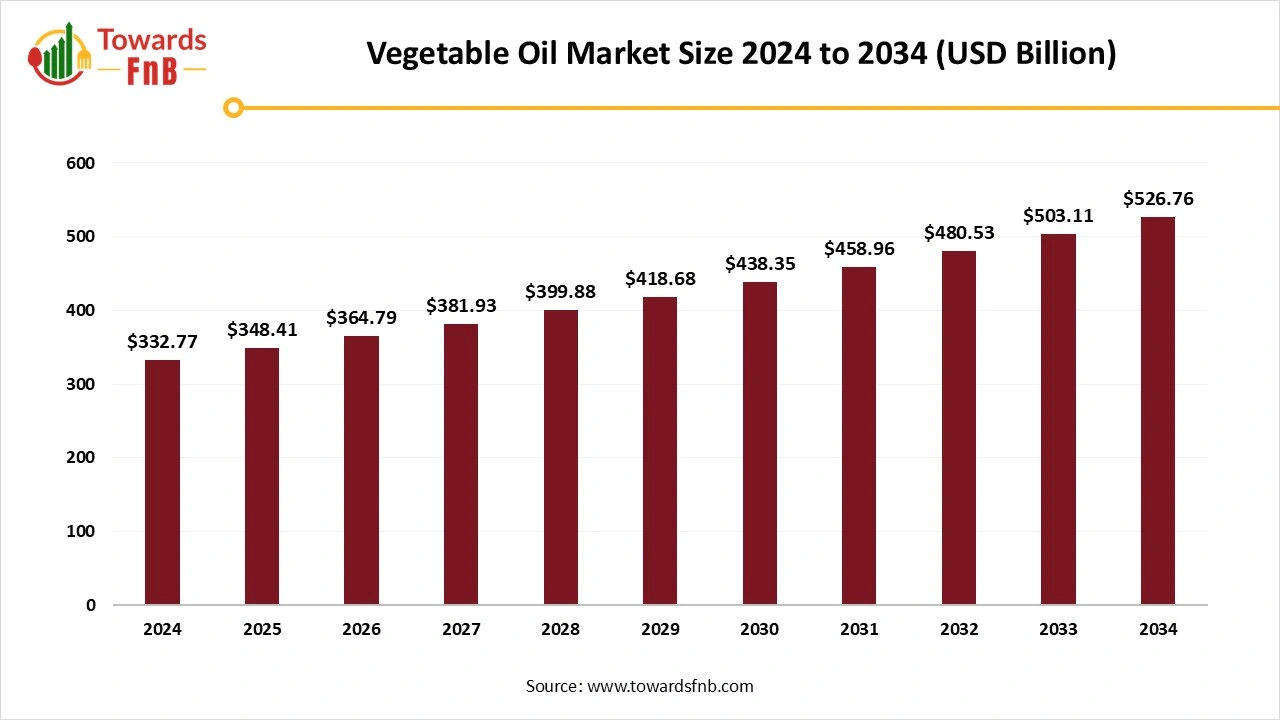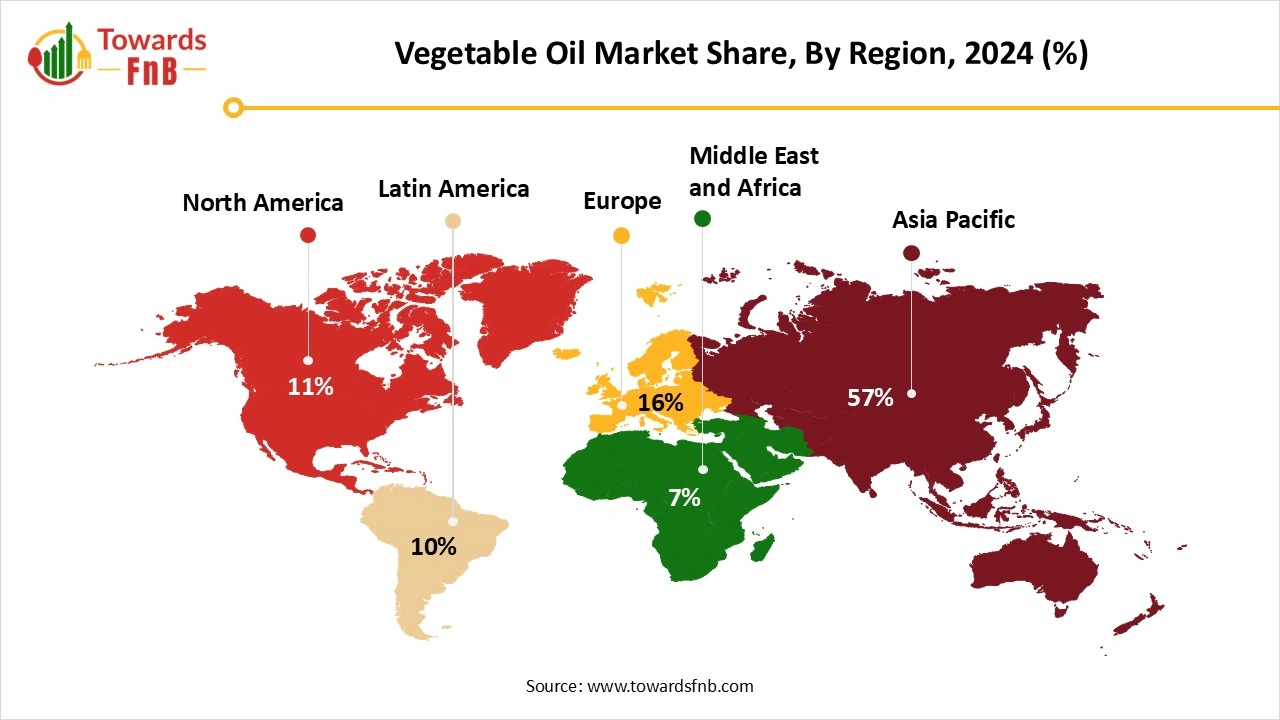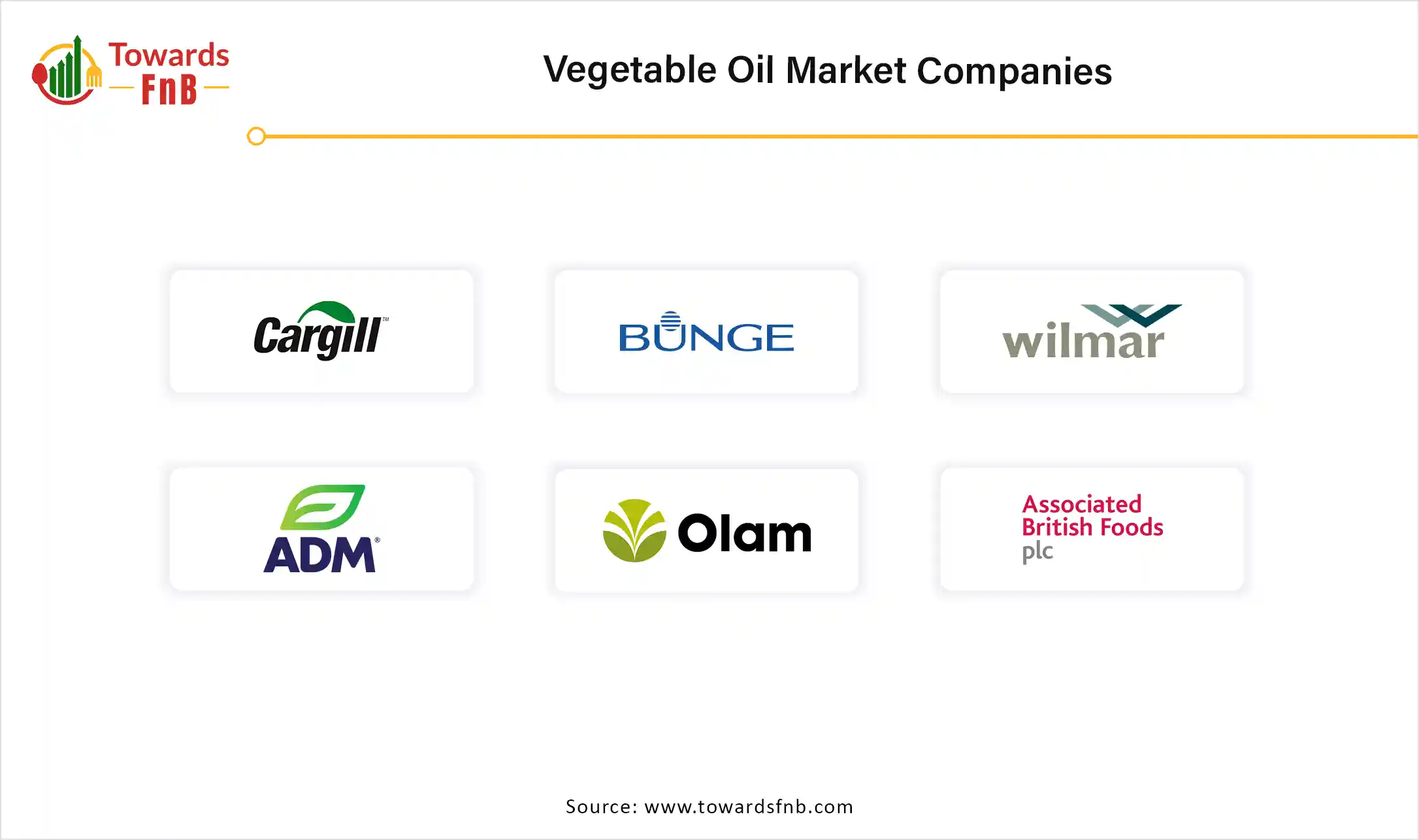November 2025
The global vegetable oil market size reached at USD 332.77 billion in 2024 and is anticipated to increase from USD 348.41 billion in 2025 to an estimated USD 526.76 billion by 2034, witnessing a CAGR of 4.7% during the forecast period from 2025 to 2034. Rising population, growing disposable income and swift urbanization, rising health awareness among consumers increasing the demand for vegetable oil and expanding the market significantly.

| Study Coverage | Details |
| Growth Rate from 2025 to 2034 | CAGR of 4.7% |
| Market Size in 2025 | USD 348.41 Billion |
| Market Size in 2026 | USD 364.79 Billion |
| Market Size by 2034 | USD 526.76 Billion |
| Largest Market | North America |
| Base Year | 2024 |
| Forecast Period | 2025 to 2034 |
| Regions Covered | North America, Europe, Asia-Pacific, Latin America, and Middle East & Africa |
Utilizing vegetable oils that contain a greater level of monounsaturated and polyunsaturated fats has gained popularity to satisfy consumer preferences for healthier cuisine. Different examples of vegetable oils include arachis, olive, canola, soybean, palm oil etc. Customer preferences greatly influence their demands as well. Research indicates that consumers are increasingly recognizing the significance of fat. Due to the advantages of specific fats for health, shoppers might choose items with better fats to promote a healthier way of living. Vegetable oils possess valuable nutritional content and chemical characteristics that render them beneficial in the production of food, cosmetics, and pharmaceuticals. Current food manufacturing heavily depends on vegetable oils utilized in cooking, baking, frying, and as components in processed foods. The USDA predicts a year-on-year increase of 2.7 million tonnes in global vegetable oil production for the current crop year 2024-25, reaching an all-time high of 224.2 million tonnes. As demand rose, consumption was projected at 221.7 million tonnes, reflecting an increase of 5.3 million tonnes from the prior year.
Technological advancement and innovation for the production extraction and refining of vegetable oil, improving the quality and yield of the oil to cater consumer preferences and expanding the market. In light of the recent push for sustainability, oilseed processing industries are seeking new oil extraction methods that are both effective and more eco-friendly. To begin with, employing novel pre-treatment methods for seeds can help enhance the extraction of vegetable oils. Secondly, a renewed focus on thermomechanical pressing is being noted, especially by utilizing twin-screw extruders instead of traditional single-screw presses. Finally, employing solvents for extraction that are less dangerous and harmful to the environment. Developing markets, especially in Asia, Africa, and Latin America, offer substantial growth potential for vegetable oil manufacturers.
The global supply chains for edible oil are deeply interlinked, meaning that a disturbance in any region can create ripple effects in markets, resulting in significant price changes. Geopolitical dynamics and trade conflicts among nations can affect the movement of vegetable oils internationally. The impact of oil production on the environment, especially regarding palm oil, is among the most critical concerns. All these factors affect by the supply chain and can disrupt supply chain.
North America Vegetable Oil Market Dominated in 2024.
As consumers adopt healthy eating choices, they prioritize vegetable oils over animal fats as they contain more unsaturated fats and have decreased level of cholesterol. This shift in accordance with plant-based diets, which prioritize entire foods and plant-derived items like vegetable oil. New product development and launches, clean labeling demand, innovative packaging solutions, and growth of product portfolio are the important strategies considered by the North America vegetable oils for which they are constantly investing in the manufacturing of healthy vegetable oils in order to provide the products to consumer at affordable market prices.

United States Vegetable Oil Market
The United Staes market is growing significantly as a result of the rising acceptance of vegetable oils for biofuel production and the export potential of the nation's processed food items. Due to the rise of fast food and shifts in consumer habits towards convenient food options, there has been a substantial rise in the demand for vegetable oils from the food processing and service sectors. As a result, the continuous demand has significantly driven the growth of the U.S. vegetable oil market. The adaptability of vegetable oils, obtained from different plant sources, renders them a crucial component in several sectors, such as food processing, pharmaceuticals, cosmetics, and industrial uses.
Asia Pacific Expects the Significant Growth in the Market During the Forecast Period.
Rising population, swift urbanization, increasing disposable income and dietary preferences are the contributing factor driving the Asia Pacific vegetable oil market. popularity of vegetable oils among consumers because of its wider application in various industries beyond the food sector. The market is being fueled further by the fact that these oils are important ingredients utilized in the formulation of soaps, detergents, cosmetics, and even biofuels. As the more people take decision of buying the vegetable oil based on healthy options and therefore there is increasing demand for the particular healthy vegetable oil. The demand for palm oil from leading global consumers China and India is projected to rise, as the vegetable oil is currently attractively priced in comparison to its competitors, according to the Malaysian Palm Oil Council (MPOC). India is among the biggest consumers and importers of vegetable oil, with a significant part of its demand fulfilled through imports.
Emerging Vegetable Oil Market of China
As incomes increase and populations become more urbanized, consumption of vegetable oil increases and benefit for the expansion of vegetable oil market in China. As increasing numbers of individuals relocate to urban regions, particularly in cities such as Beijing and Shanghai, the usage of vegetable oil escalates. Brand recognition and reputation are essential for marketing vegetable oils in China. Brands utilize multiple platforms for product promotion, including Xiaohongshu, WeChat, and Douyin, which serve as significant marketing channels and powerful e-commerce platforms.
The Palm Oil Segment Dominated the Vegetable Oil Market with the Largest Share in 2024.
Palm oil is commonly utilized in the food and beverage sector due to its adaptable characteristics, such as its mild taste, elevated smoke point, and strong oxidative stability. The growing food and beverage sector is providing profitable growth prospects for the entire market. Indonesia is the biggest producer and exporter of palm oil. Palm oil and its by-products are extensively utilized in cosmetics and personal care items. The expanding cosmetics market, along with the need for sustainable ingredients, presents opportunities for palm oil producers to provide certified sustainable palm oil to these sectors. The palm oil sector generates revenue, commerce, and employment in producing countries, providing livelihoods for millions of smallholder farmers. In both Indonesia and Malaysia, 4.5 million individuals depend on the palm oil sector for their income. Today, farmers generate over 70 million tonnes of palm oil annually which is more than twice the amount they produced two decades ago.
Soybean Oil Segment is Observed to Grow at the Fastest Rate During the Forecast Period.
Soyabean oil most widely consumed oil globally and it is used in the various sectors like cooking, food processing, and industrial items. rising demand for healthier food choices as health awareness is rising consumers, they are opting for healthier eating habits, including cooking oil with low in saturated fat and high in unsaturated fat is anticipated to propel the soybean oil market expansion.
The Food Segment Held the Largest Share of the Vegetable Oil Market in 2024.
Vegetable oils are important in the food sector and diet as the preliminary source of energy. They also offer vital functions in the development of numerous ingredients. Versatile application and nutritional benefits of the vegetable oils increasing their demand in food industry. Expanding food service sector further boosting the market. vegetable oil is widely used in the cooking, frying salad dressing and marinades, baking products, sauces and condiments as well as in non-dairy alternatives.
The Industrial Segment is Seen to Grow at a Notable Rate During the Predicted Timeframe.
Among various vegetable oils such as palm oil, soybean oil, and rapeseed oil are globally significant due to their substantial worldwide production and cost-effectiveness for extensive industrial applications. In recent years, the utilization of vegetable oils has gained significant attention in various small- and large-scale sectors, including soaps, lubricants, biofuels, paints, and more. Vegetable oil finds application in food processing sectors, electrical industries, biodiesels for internal combustion engines, cutting fluids for machining, and HTF for heating and cooling purposes.
B2B Segment held the Dominating Share of the Vegetable Oil Market in 2024.
B2B distribution channel emphasizes developing connections and offering value to other businesses. These channels may consist of digital platforms, direct sales, collaborations, and events, each customized to address the unique requirements and desires of corporate clients. B2B fulfillment and distribution centers utilize advanced tracking systems, enabling companies to track shipments live. Various companies depend on large acquisitions of vegetable oils for cooking, food production, and ingredient development and therefore mostly B2B distribution channel for buying the vegetable oil
B2C Segment is Expected to Grow at the Fastest Rate in the Market During the Forecast Period.
B2C distribution channel enables companies to engage with their desired customers and enhance brand recognition. Successful marketing campaigns can aid businesses in drawing in new customers, keeping current ones, and boosting sales and revenue. B2C E-Commerce has expanded swiftly in recent years, fueled by technological advancements and evolving consumer habits. E-commerce platforms provide shoppers the ease of making purchases from any location, at any hour, without the necessity of going to a brick-and-mortar shop.
Patanjali Foods Ltd.
Market Expansion: In March 2025, Patanjali Foods Ltd. planned to set up an oil palm mill in Mizoram as part of its initiative to grow its presence in India's edible oil retail market, an official revealed. Two top company officials met with Chief Minister Lalduhoma in Aizawl to discuss the venture. The mill is set to be established in Liapha, Lawngtlai district, and is anticipated to be finished within a year, as stated by the official. (Source: Indian retailer)
Annapurna Swadisht Ltd
Acquisition: In March 2024, packaged food firm Annapurna Swadisht Ltd purchased mustard oil brand 'Arati' from R R Proteins and Agro Ltd. The purchase introduced the brand in the FMCG industry. (Source: Business-Standard)

By Type
By Application
By Distribution Channel
By Region
November 2025
November 2025
November 2025
November 2025